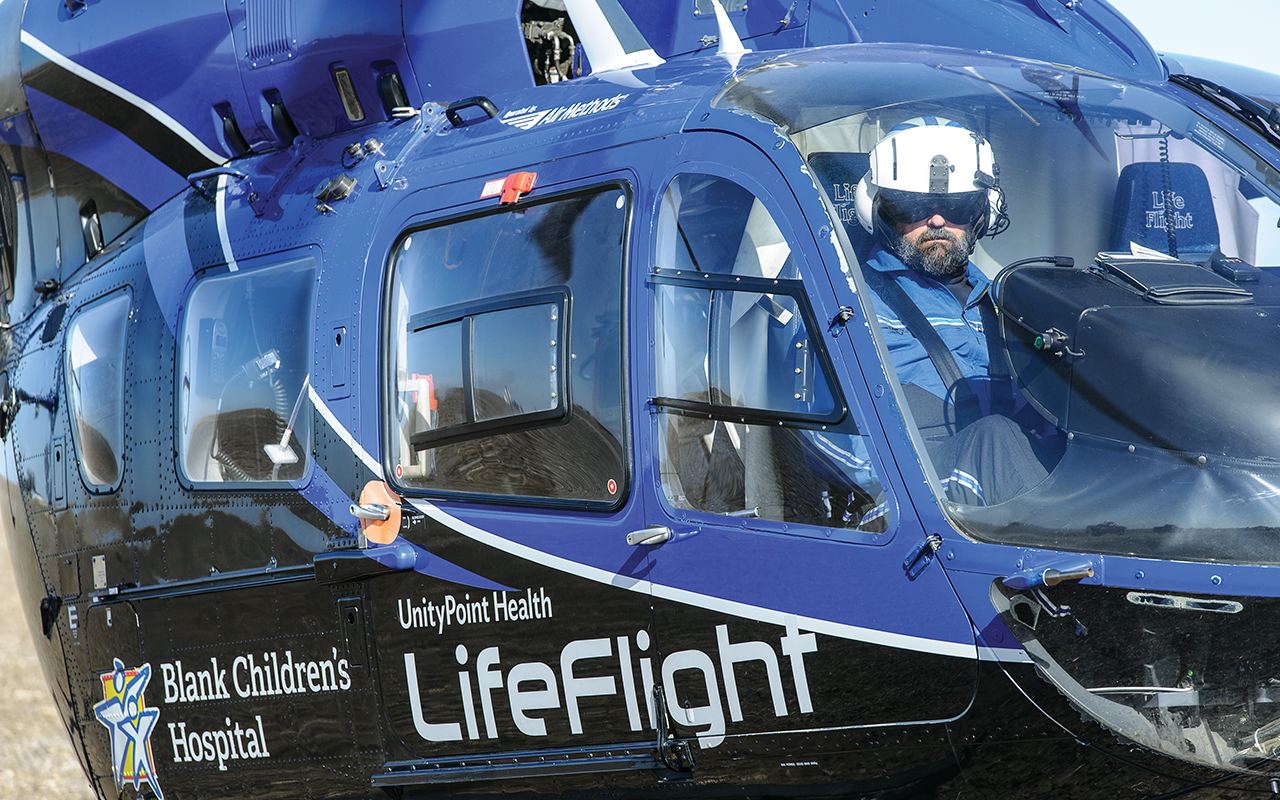Above: Pilot Alan Carver keeps the LifeFlight helicopter ready for the crew to “hot load” a patient for transfer to a UnityPoint Health hospital. LifeFlight received more than 1,200 requests for air transports in 2017.
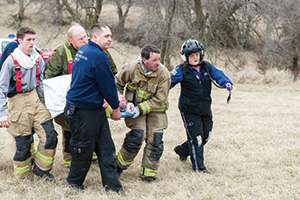
Writer: Barbara Dietrich Boose
Photographer: Bob Blanchard
On a sunny Monday afternoon outside Stuart, Iowa, things have gone from bad to worse. A grass fire is threatening buildings and a man has fallen from his firetruck, injuring his back and neck. Colleagues have lifted him onto a backboard, immobilizing his head. Now they raise their eyes to the sky, to an approaching helicopter.
As UnityPoint’s LifeFlight chopper lands, nurse Lynette Hemphill emerges while her partner this day, Ben Schloss, gathers the red “stat pack.” They quickly get details from the firefighters, then Schloss opens the helicopter’s doors to receive the injured man while Hemphill directs the group transporting him. Back in the air, they calmly talk with their patient, administer pain medication and monitor his vitals while pilot Nick Olson communicates with dispatchers at Iowa Methodist Medical Center. Upon arrival, they wheel their patient into the emergency room and explain what they’ve learned to the trauma room staff.
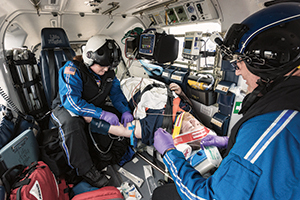
At work on this day and during the nearly 40 years that preceded it are some extraordinary professionals—the women and men who staff LifeFlight, the transport program of UnityPoint Health—plus their helicopters and ambulances. The aircraft and vehicles are state-of-the-art; the nurses, paramedics and pilots embody a heroic mix of heart, knowledge and skill. In 2019, LifeFlight will mark four decades of saving lives. It was the first of five air medical transport programs that now operate in the state.
“You have to be passionate about it. It’s hard work, long hours, you’re out in the cold, out in the heat,” says Laurie Gehrke, a pediatric transport nurse who joined LifeFlight in 2000. “We look for people who have that desire, who are humble, who understand you’re going to be put in an environment in which you have no idea what resources you’ll have. You do it because you want to. There’s no glamour in a 3 a.m. flight when you’re in the dark, trying to lay a line in a child’s arm.”
There’s also no glamour in the flipside of the crew’s shifts, when no calls come in or they’re grounded by weather conditions. Not that crew members are then sitting on their hands: They help in the emergency room and intensive care unit, check on patients they’ve transported, participate in training, restock the helicopter, check supplies, and travel the state to provide education to local law enforcement, fire departments, hospitals, first responders and organizations like schools and large confined-animal facilities that want training in “mock disasters.”
“We are always busy,” says flight nurse Chrissi Boston.
Like many of her colleagues, she admits that being grounded makes her antsy. “I don’t want to say we thrive on the unpredictability, but we kind of do,” she says. “You never know what’s going to happen. We’re all adrenaline junkies. The job really is a calling. Every time I get into the helicopter, I say I have the best job in the world.”
Keeping cool in the face of unpredictability is just part of the job. “It’s all training, all knowledge,” says flight nurse Ben Harman. “Fear is just the lack of knowledge.”
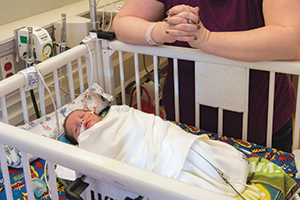
Struggling for Life, at Birth
What should have been some of Timara Ekstein and fiancé Brannan Groves’ happiest days had turned into a nightmare. At 37 weeks into what would have been a typical 40-week pregnancy, Ekstein’s blood pressure had gone “through the roof,” she says, and her gestational diabetes was affecting their baby. Her mother took her to the hospital in Centerville, but because its obstetrics center was closed at the time, Ekstein was rushed by ambulance to Ottumwa, lights flashing and sirens blaring. Her blood pressure was 199 over 135, compared with a healthy pregnancy blood pressure of 140 over 90.
“I dilated at four centimeters,” she recalls. “A half-hour later, I was at seven centimeters. After that, I don’t remember anything.”
That includes the birth of son Braxton. While his weight of 5 pounds, 6 ounces, wasn’t problematic, a placental abruption—in which the placenta tears away from the uterine wall—threatened adequate flow of oxygen to his brain. The newborn had to be resuscitated.
Eventually conscious, Ekstein panicked to find out what had happened to her son. “I was told he was not going to make it,” she says. Then the hospital staff decided to call LifeFlight.
“I was scared for them to take him, and I couldn’t go with him,” says Ekstein, now beaming over her sleeping 5-pound, 12-ounce baby boy in his room at UnityPoint’s Blank Children’s Hospital. But it had been difficult seeing Braxton leave while she stayed in Ottumwa.
“After [the LifeFlight crew] came in and talked to me, it was a massive relief. [Nurse] Kristy Oswald told me they were going to do anything and everything in their power to help him. She explained all his conditions, what each person in the room was doing and what was going to happen—and not in ‘doctor-speak.’ My blood pressure immediately went down.”
Neonatal nurse Oswald has been a member of the medical transport team for more than 30 years. “What I always tell the flight crew is that I have the best job. In what other job do you get to fly and rock a baby?”
Of course, not every case has a good outcome. “You have to be empathetic, personal and professional, and put it all together,” Oswald says. “I’ve had to say to parents, ‘I’m sorry, there’s nothing more I can do. Would you like to hold your baby?’ That’s tough, telling a parent that the child has died or is dying or won’t survive the flight. I have to have that honest conversation with extreme compassion, kindness and sincerity.” And, she adds, “I’m not afraid to give them a hug.”
From the Pilot’s Seat
Alan Carver flips seemingly dozens of switches and checks multiple screens on the dashboard of the 708-horsepower 2007 Eurocopter known by its FFA registration, N779LF. He checks some flight notes he’s inked on the inside of his wrist. All the while he’s communicating via radio to the helmeted LifeFlight crew, air traffic control, dispatchers at Iowa Methodist Medical Center and other medical transport crews around the state.
“Everyone ready?” he asks the crew, which, as is typical, consists of two flight nurses. Affirmed, he pulls back on the lever on his left, which lifts the aircraft to the day’s emergency: a disaster scene near Gilman, Iowa, involving two school buses that have rolled over and a tractor with a sprayer. A hazardous chemical may be involved, and multiple people, mostly kids, are injured.
Except they aren’t. This disaster is only a drill, designed to help volunteer fire and rescue departments practice their skills, including how to identify a safe landing zone for medical crews. Mercy Medical Center’s transport helicopter is participating, too; it flies to the south of LifeFlight’s.
“The cooperation between us and Mercy is phenomenal,” Carver says. “It used to be competitive.”
In fact, there is intentional, ongoing cooperation among Iowa’s five medical transport programs and with many others. “Without first responders, we couldn’t do what we do,” flight nurse Tammy Apana says later. “I can’t say enough about those people in the local communities. We aren’t this tiny team that does this work. This team is very large. It isn’t just the LifeFlight crew, but also the emergency medical people, the local hospitals and law enforcement. It takes all of us to make our program successful.”
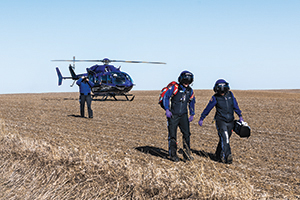
When All Isn’t Enough
There are difficult shifts. Pediatric transport nurse Laurie Gehrke has had to ask parents what they want to do when there’s nothing more she can do. “We engage the family in making decisions. I turn my focus to the parents—what they recall about their child, what meant the most to them,” she says. “In one case, the parents wanted their baby to get CPR until their pastor could arrive to perform the baptism. So we did while they held their baby.”
There are cases where crew members have to advise against transporting a patient they believe is dying. “We want to be honest with the patient’s loved ones,” says Michael Zweigart, paramedic flight nurse and LifeFlight’s program manager. “We don’t want to add to their hardship by transporting the patient to Des Moines.”
For each of the tough cases, Gehrke notes, there are “hundreds of great outcomes.” She recalls a case in which a failing child revived after Gehrke suggested her mother tell the child she loved her. She says she gets “the loveliest Christmas card” every year from a family whose son she cared for. “I look forward to that Christmas card every year,” she says. “I have them all. Sometimes when I’m having a bad day, I pull out one of those cards.”
LifeFlight nurse Chrissi Boston occasionally receives photos of a former patient playing pickleball and hiking in Arizona. “Every once in a while, you have that connection with a patient,” she says. The man was visiting Iowa from Wisconsin and suffered a stroke. After flying him from Clarke County to Iowa Methodist Medical Center, Boston went to his room to check on him. She tears up recalling seeing the “code cart”—equipment hospital staff use for a patient in a cardiopulmonary emergency—but was relieved to learn he had recovered.
“I was there the day he got to go home,” she says. “We took him up to the helicopter because he didn’t remember his flight. I still text him.”
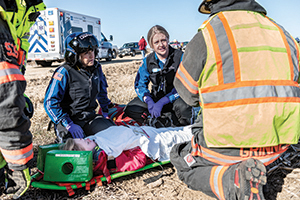
with a first responder during the exercise.
‘It Could Have Been Scary’
Pilot Bryon Capouch begins this day’s LifeFlight crew shift with a briefing on weather conditions, visibility, wind speeds and the forecast. Perhaps for the benefit of a fly-along guest, his “random topic of the day” is the rule of maintaining a “sterile” cockpit, in which there’s no unnecessary chatter for two minutes after liftoff and before landing.
Capouch joined Air Methods, the company that owns and maintains LifeFlight’s helicopters, after two military deployments to Iraq and two to Bosnia. He performed air assault missions and then transitioned to medical evacuations. Now the taciturn pilot’s top priority is the safety of the LifeFlight crew. Flight nurse Tammy Apana saw that in action during a flight to a vehicle collision in southwest Iowa one wintry night, when visibility was diminishing and precipitation was building on the surface of the helicopter, which has no de-icing capabilities.
“He told us we had to land,” she says. “It could have been a scary incident, but it wasn’t at all. At no point was I afraid, because Bryon talked us through everything.”
That night, the crew landed in a cornfield near Corning.
A couple in a pickup truck stopped and told the crew to help themselves to their home and bathroom nearby. The crew notified UnityPoint’s dispatchers, who alerted the sheriff.
“The sheriff got us to the patient’s bedside,” Apana says. Unfortunately, the patient had probably suffered a cardiac event prior to the collision and, with a do-not-resuscitate directive, he died. But the event underscored the specific roles that LifeFlight crew members play.
“Our pilots are always watching out for us,” Apana says.
“Safety is first and foremost in their priorities. We all work to build that trust and communication with each other.”

Command Central
In a small windowless room on the first floor of Methodist, LifeFlight nurses Tammy Apana and Liz Wyman sit at computers, reviewing patient information and making notes. A large monitor hanging on the wall displays a weather map of Iowa, pinpointing the locations of any airborne medical helicopters, their altitude, speed and flight paths. The room has a few filing cabinets, a small refrigerator and an overall Spartan environment save for a photo booth strip of some LifeFlight crew members, large framed photographs of LifeFlight helicopters and the friendly conversations that occur here.
This is “command central” for the emergency transport staff. It’s just after 7 a.m. and the nurses are tucking into breakfast—toast with peanut butter and avocado slices for Apana and breakfast casserole from the hospital cafeteria for Wyman. Fellow nurse Lynette Hemphill enters with a plastic-foam clamshell containing eggs and sausage.
“The rule,” she says, “is always have a full stomach and an empty bladder.”
It’s the start of a 12-hour shift for these nurses, who are ready and waiting for an emergency call. In the meantime, Apana and Wyman take a lap around Iowa Methodist’s trauma center and then head to the ambulance garage, stopping at the dispatchers’ transfer center. In the tiny windowless room, two dispatchers and three transfer staff members watch monitors that track medical service flights around the state. They communicate with the emergency staff and take calls from first responders, other hospitals, nursing homes and health care providers seeking to transfer patients by air or ground. The staff handles communications for UnityPoint hospitals in Des Moines, Trinity Medical Center in Fort Dodge and Allen Hospital in Waterloo. While arranging the transportation of patients, they consult with physicians seeking to transfer them and those who will receive them.
“I like the autonomy of it. You get to make a lot of decisions,” says Doug Strickler, manager of the UnityPoint transfer center and LifeFlight communications. “I like how complicated it is and the logistical part of making the best use of our aircraft and ambulances. We’re a conduit between the aviation side and the medical side.”
Strickler got started in medical transport in 2000. “We did all the flight tracking on a piece of paper,” he says. “There was no GPS, no automatic tracking.”
On this day, Ben Schloss is working dispatch; he’s also been a flight nurse for more than 17 years. He proudly notes the dispatchers’ combined 110 years of dispatch experience. “They call us the retirement home,” he says.
Schloss says he enjoys working with Apana and Wyman because “their communications are very short since they know each other so well.”
Wyman adds, “It’s really cool when you find that partner and you’re like, ‘Hey, I think we exchanged two words on that trip.’ It’s a high-five moment.”
Highway Amputation?
Lisa Dooly does not remember July 1, 2016. She and her husband, Bob, had taken that Friday off work to extend their Fourth of July weekend, kicking it off with a leisurely late-morning ride on their Harley-Davidson motorcycle on Iowa Highway 141 near Grimes. Then a car attempting to cross the divided highway collided with them. First responders called Mercy Medical Center to transport Bob by ambulance and summoned UnityPoint’s LifeFlight for Lisa.
“When we got on the scene, she was still entrapped by the motorcycle,” says Jerrica Moon, one of the flight nurses on the call that day. “She was partially impaled in her upper thigh. We had three options: pull the motorcycle off and hope it comes out clean; remove the part of the bike that was possibly piercing her femoral artery; or fly the trauma surgeon out to remove her leg.”
As the emergency crew worked to dismantle the motorcycle, Dooly’s blood pressure began to plummet. She was losing consciousness.
“We had to quickly formulate a plan,” Moon says. “We had the pilot start up the helicopter, and we started to give Lisa blood while she was still entrapped. If we hadn’t, there’s no doubt in my mind she’d be dead now.”
Dooly wasn’t out of the woods, however. In Iowa Methodist’s trauma center, she “coded”—meaning her breathing and/or pulse stopped—three times. Surgeons opened her chest to apply an aortic clamp that directed what blood she had left to just her heart and brain.
“I walked away from the trauma bay and cried,” Moon says.
After numerous surgeries and 83 days in the hospital, though, Dooly went home—with a limp and likely knee replacement in her future, but alive and mobile.
“Des Moines is blessed to have such wonderful health care professionals,” she says. “They sacrifice, they’re away from their families, they work long days and they see horrible things. The LifeFlight crew didn’t just save my life. They came up to see how I was doing in the hospital. It’s not just their talent, skills and equipment; it’s the personal connections they maintain.”
Moon, who says she has her “dream job,” praises her colleagues as being “amazing at supporting each other.” In April, she and Tammy Williams, her fellow flight nurse on Dooly’s case, and Mark Bragg, the pilot that day, got a message from Dooly. It said, “Thanks to you guys, I got to be the mother of the bride again.”
“When I hear the LifeFlight helicopter, it’s not a traumatic sound to me,” Dooly says. “I worry because somebody needs them, but it gives me hope that they’re on the way. They’re incredible people. There are some angels in the air for us.”
Fast Facts
- LifeFlight received more than 1,200 requests for air transports in 2017. Calls have come from 85 of Iowa’s 99 counties.
- Its helicopters are owned and maintained by Air Methods, which also employs the pilots.
- Of its total flight volume, 75 percent involve adult patients; 16 percent, pediatric; and 9 percent, neonatal.
- Cases include trauma (21 percent), neurological emergencies
(18 percent), respiratory emergencies (17 percent) and cardiac cases
(17 percent). - LifeFlight transports patients to any appropriate facility, primarily in Iowa, Minnesota and Nebraska.
- A crew on a flight typically is a pilot and two nurses (or a nurse and a paramedic). Nurses and paramedics are trained in advanced procedures including surgical skills, and they obtain national certification in their area of specialty.

